engine Alfa Romeo 8C 2010 Owner handbook (in English)
[x] Cancel search | Manufacturer: ALFA ROMEO, Model Year: 2010, Model line: 8C, Model: Alfa Romeo 8C 2010Pages: 223, PDF Size: 14.35 MB
Page 161 of 223
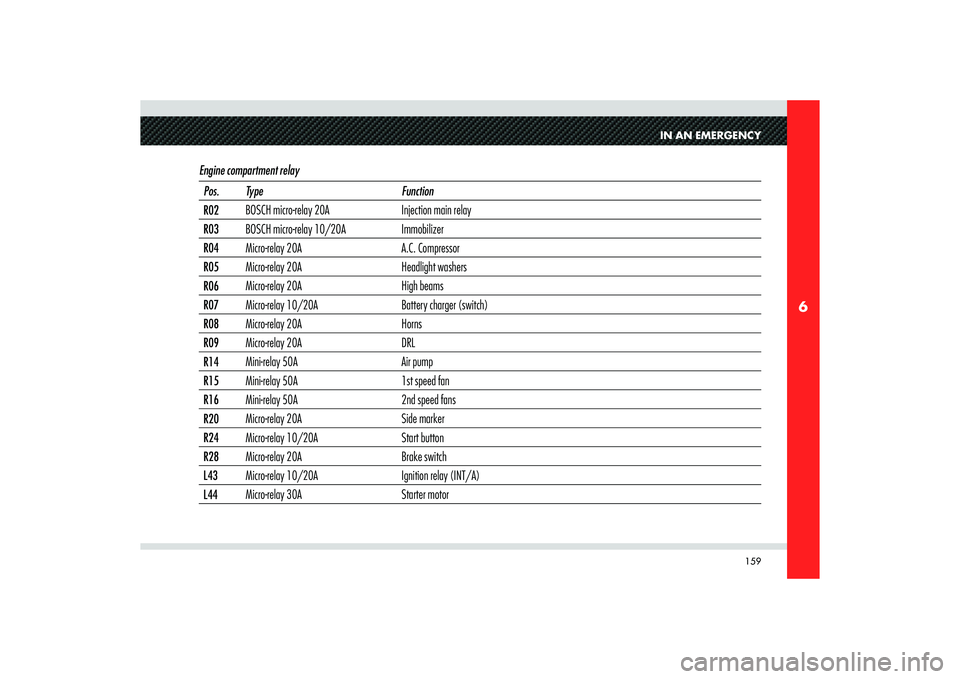
159
6
IN AN EMERGENCY
Engine compartment relay Pos. Type Function
R02BOSCH micro-relay 20A Injection main relay
R03BOSCH micro-relay 10/20A Immobilizer
R04Micro-relay 20A A.C. Compressor
R05Micro-relay 20A Headlight washers
R06Micro-relay 20A High beams
R07Micro-relay 10/20A Battery charger (switch)
R08Micro-relay 20A Horns
R09Micro-relay 20A DRL
R14Mini-relay 50A Air pump
R15Mini-relay 50A 1st speed fan
R16Mini-relay 50A 2nd speed fans
R20Micro-relay 20A Side marker
R24Micro-relay 10/20A Start button
R28Micro-relay 20A Brake switch
L43Micro-relay 10/20A Ignition relay (INT/A)
L44Micro-relay 30A Starter motor
Page 162 of 223
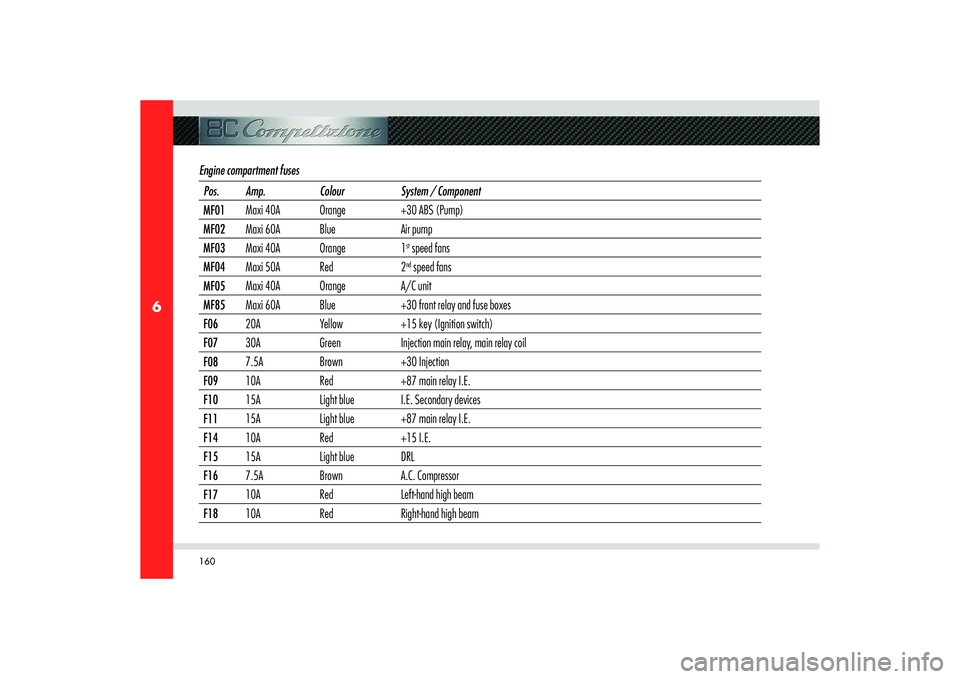
160
6
Engine compartment fuses Pos. Amp. Colour System / Component
MF01Maxi 40A Orange +30 ABS (Pump)
MF02Maxi 60A Blue Air pump
MF03Maxi 40A Orange 1
st speed fans
MF04Maxi 50A Red 2nd speed fans
MF05Maxi 40A Orange A/C unit
MF85Maxi 60A Blue +30 front relay and fuse boxes
F0620A Yellow +15 key (Ignition switch)
F0730A Green Injection main relay, main relay coil
F087.5A Brown +30 Injection
F0910A Red +87 main relay I.E.
F1015A Light blue I.E. Secondary devices
F1115A Light blue +87 main relay I.E.
F1410A Red +15 I.E.
F1515A Light blue DRL
F167.5A Brown A.C. Compressor
F1710A Red Left-hand high beam
F1810A Red Right-hand high beam
Page 165 of 223
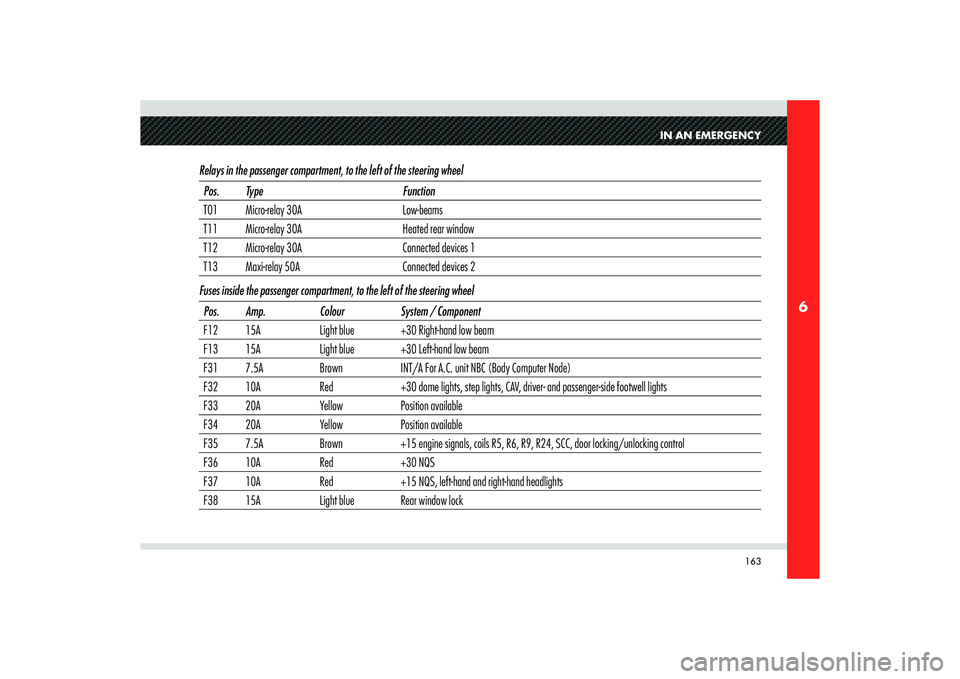
163
6
IN AN EMERGENCY
Relays in the passenger compartment, to the left of the steering wheelPos. Type Function
T01 Micro-relay 30A Low-beams
T11 Micro-relay 30A Heated rear window
T12 Micro-relay 30A Connected devices 1
T13 Maxi-relay 50A Connected devices 2
Fuses inside the passenger compartment, to the left of the steering wheel
Pos. Amp. Colour System / Component
F12 15A Light blue +30 Right-hand low beam
F13 15A Light blue +30 Left-hand low beam
F31 7.5A Brown INT/A For A.C. unit NBC (Body Computer Node)
F32 10A Red +30 dome lights, step lights, CAV, driver- and passenger-side footwell lights
F33 20A Yellow Position available
F34 20A Yellow Position available
F35 7.5A Brown +15 engine signals, coils R5, R6, R9, R24, SCC, door locking/unlocking control
F36 10A Red +30 NQS
F37 10A Red +15 NQS, left-hand and right-hand headlights
F38 15A Light blue Rear window lock
Page 170 of 223

168
6
B
C
A
IF THE BATTERY IS
FLAT First of all, we recommend that you read
the precautions contained in the section
”Maintenance“ to prevent the battery from
running flat and to help ensure its long life.
STARTING WITH THE
AUXILIARY BATTERY
See the chapter ”Starting the engine“ on page
114 in the section ”Using the vehicle”.WARNING: Under no circumstance should a
battery be used for an emergency start-up: This
could damage the electronic systems, particularly
the control units managing the ignition and fuel
supply functions.
RECHARGING THE
BATTERY
You are advised to recharge the battery slowly
and at a low amperage for about 24 hours.
Proceed as follows:
1) Deactivate the electronic alarm using the
radio control.
2) Lift the rear shelf
A and the box cover
B
and release the hooks
C.
WARNING: First disconnect the negative pole
terminal (–) then the positive pole one (+).3) Connect the battery charger cables to the
battery poles.WARNING: The battery is housed in a metal box, therefore, be extremely careful not to let the
battery charger clips come into contact with it.
4) Turn on the battery charger.
5) When the battery is recharged, turn off the
battery charger before disconnecting it from
the battery.
6) Reconnect the terminals to the battery
poles, observing the polarity.WARNING: First reconnect the positive pole
terminal (+) and then the negative pole one
(–).
WARNING: Before reconnecting the battery
terminals, check that the key has been removed
from the ignition or at least that it is in the STOP
position.
Page 172 of 223

170
6
IF YOU HAVE TO
TOW THE VEHICLE If you need to tow the vehicle, observe the
following recommendations:
- if possible, have the vehicle transported on
a vehicle equipped with loading platform
and specifi c for roadside assistance and
recovery.
If this is not possible:
- Tow the vehicle for a stretch of less than
100 km at a speed below 60 km/h, using
the towing hook provided in the toolkit.To be able to tow the vehicle, you must:
- Turn the ignition key to MAR without
starting the engine (see page 87)
- Engage neutral (position N) by
simultaneously pulling the gearshift paddles
UP and DOWN while holding the brake
pedal depressed (see page 118)
- turn the key back to position STOP.
CAUTION
Do not extract the key, as the
steering wheel will lock automatically
and you will be unable to steer the
wheels.
CAUTION
When towing the vehicle, make
sure that you observe the road traffic
regulations concerning both the towing
device and driving conduct.CAUTION
When towing the vehicle with
the engine off, remember that, without
the assistance of the brake servo, a
stronger effort is required on the brake
pedal for braking and on the steering
wheel for steering.
CAUTION
Screw down the towing hook
into its seat (approx. 11 turns).
Accurately clean the threaded seat
before tightening the hook.
WARNING: If you have to tow the vehicle with 2
wheels raised, ensure that the ignition key is in
the STOP position. Otherwise, when the VDC is
active, the relative ECU will store a malfunction,
which will cause the illumination of the warning
light
on the instrument panel display. This
requires the intervention of an Authorised
Service Centre of the Manufacturer’s Network
to correct the system malfunction.
Page 173 of 223

171
6
IN AN EMERGENCY
IN THE EVENT OF
AN ACCIDENT It is important always to stay calm.
- If you are not directly involved, stop at a
distance of at least ten metres away from
the accident area.
- If you are on a highway, stop without
obstructing the emergency lane.
- Turn off the engine and turn on the hazard
warning lights.
- At night, illuminate the accident area with
the headlights.
- Always act with caution: you should not risk
someone crashing into you.
- Indicate that an accident has occurred
by placing the emergency triangle in a
well visible position and at the prescribed
distance.
- Call the emergency services, providing as
much information as possible. On highways,
use the special emergency call boxes.
- Remove the ignition key from the vehicles
involved.
- If you smell fuel or other chemical products,
do not smoke and ask people around you to put their cigarettes out.
To extinguish fires, even small ones, use a fire
extinguisher, blankets, sand or earth. Never use
water.
In multiple accidents occurred on highways,
particularly where visibility is poor, there is a
high risk of being involved in other collisions.
Leave your vehicle immediately and move away
from it. IF THERE ARE INJURED
PERSONS
- Never leave an injured person alone.
Persons not directly involved in the accident
are also required to give assistance.
- Do not crowd around injured persons.
- Reassure the injured person that aids are on
the way and stay close to them to help with
possible panic attacks.
- Unfasten or cut the seat belts restraining
the injured persons.
- Do not give the injured persons anything to
drink.
- The injured person should never be moved.
- Remove the injured person from the vehicle
only if there is a risk of fi re, sinking in water
or falling down into a pit. When removing
an injured person, do not pull his/her limbs,
bend his/her head and, as far as possible,
keep the body in a horizontal position.
Page 177 of 223
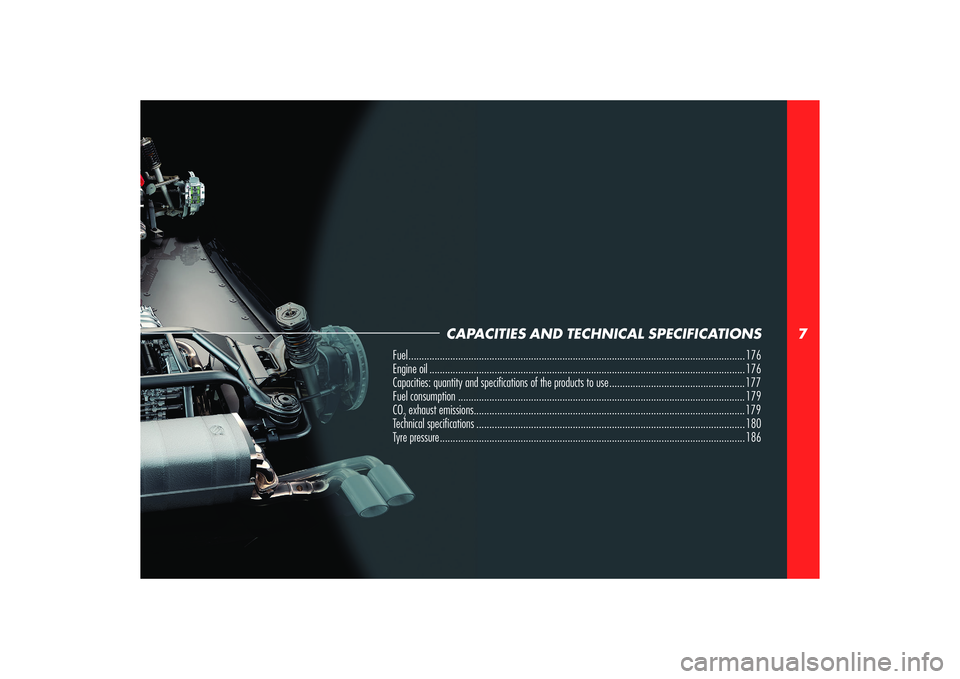
7
CAPACITIES AND TECHNICAL SPECIFICATIONS
Fuel ................................................................................................................................. 176
Engine oil ......................................................................................................................... 176
Capacities: quantity and specifi cations of the products to use .................................................... 177
Fuel consumption ..............................................................................................................179
CO2 exhaust emissions ........................................................................................................ 179
Technical specifi cations ....................................................................................................... 180
Tyre pressure ..................................................................................................................... 186
Page 178 of 223
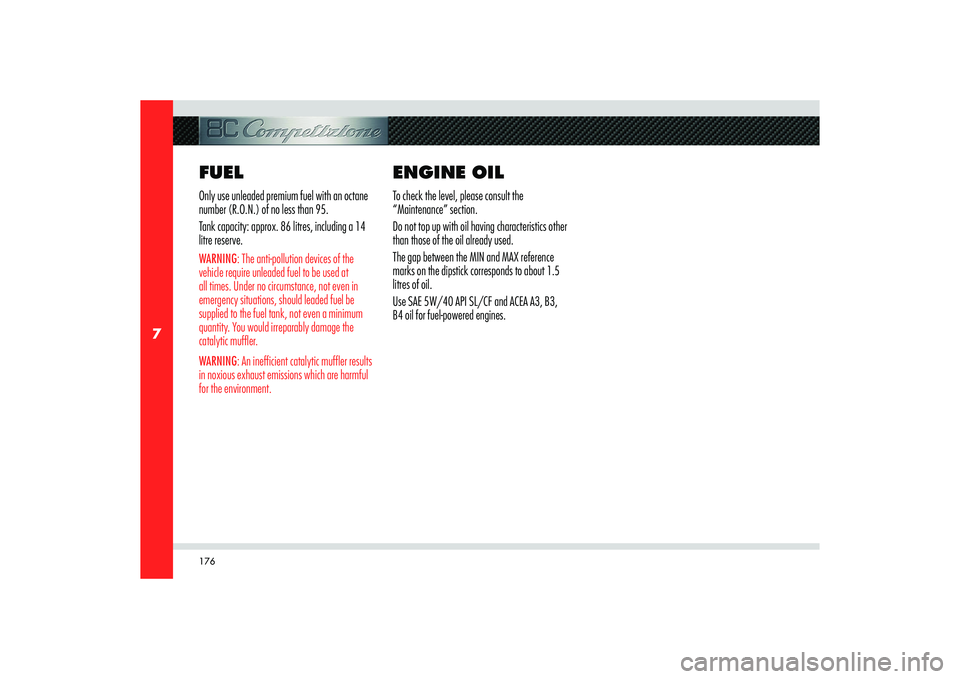
176
7
FUELOnly use unleaded premium fuel with an octane
number (R.O.N.) of no less than 95.
Tank capacity: approx. 86 litres, including a 14
litre reserve.WARNING: The anti-pollution devices of the
vehicle require unleaded fuel to be used at
all times. Under no circumstance, not even in
emergency situations, should leaded fuel be
supplied to the fuel tank, not even a minimum
quantity. You would irreparably damage the
catalytic muffler.
WARNING: An inefficient catalytic muffler results
in noxious exhaust emissions which are harmful
for the environment.
ENGINE OILTo check the level, please consult the
“Maintenance” section.
Do not top up with oil having characteristics other
than those of the oil already used.
The gap between the MIN and MAX reference
marks on the dipstick corresponds to about 1.5
litres of oil.
Use SAE 5W/40 API SL/CF and ACEA A3, B3,
B4 oil for fuel-powered engines.
Page 179 of 223
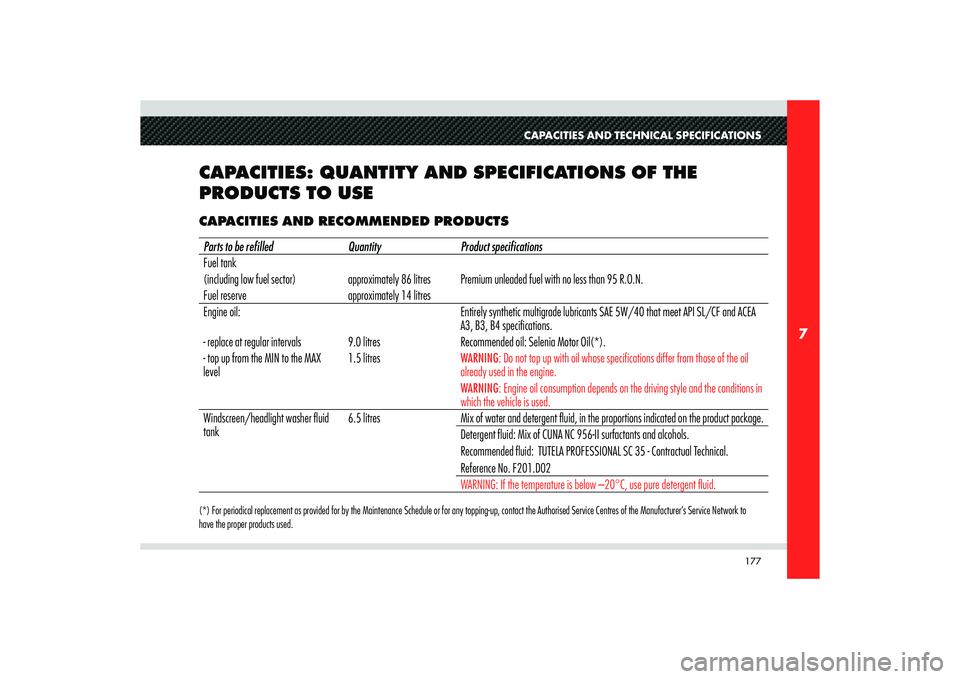
177
7
CAPACITIES AND TECHNICAL SPECIFICATIONS
CAPACITIES: QUANTITY AND SPECIFICATIONS OF THE
PRODUCTS TO USECAPACITIES AND RECOMMENDED PRODUCTS(*) For periodical replacement as provided for by the Maintenance Schedule or for any topping-up, contact the Authorised Service Centres of the Manufacturer’s Service Network to
have the proper products used. Parts to be refi lled Quantity Product specifi cations
Fuel tank
(including low fuel sector) approximately 86 litres Premium unleaded fuel with no less than 95 R.O.N.
Fuel reserve approximately 14 litres
Engine oil: Entirely synthetic multigrade lubricants SAE 5W/40 that meet API SL/CF and ACEA
A3, B3, B4 specifications.
- replace at regular intervals 9.0 litres Recommended oil: Selenia Motor Oil(*).
- top up from the MIN to the MAX
level1.5 litres
WARNING: Do not top up with oil whose specifications differ from those of the oil
already used in the engine.
WARNING: Engine oil consumption depends on the driving style and the conditions in
which the vehicle is used.
Windscreen/headlight washer fluid
tank6.5 litres Mix of water and detergent fluid, in the proportions indicated on the product package.
Detergent fluid: Mix of CUNA NC 956-II surfactants and alcohols.
Recommended fluid: TUTELA PROFESSIONAL SC 35 - Contractual Technical.
Reference No. F201.D02
WARNING: If the temperature is below –20°C, use pure detergent fluid.
Page 180 of 223
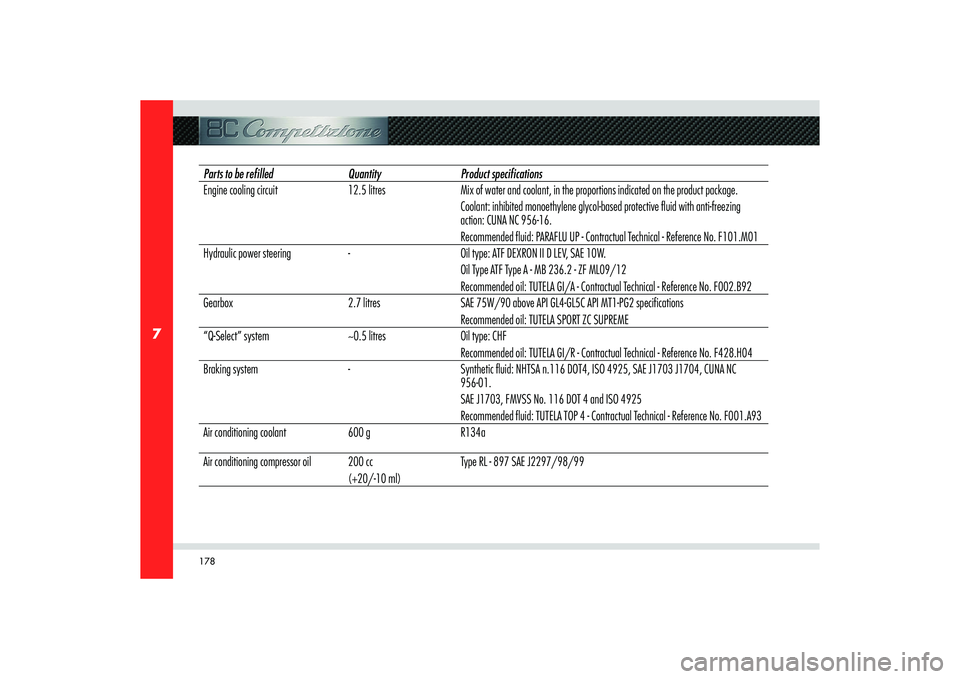
178
7
Parts to be refi lled Quantity Product specifi cations
Engine cooling circuit 12.5 litres Mix of water and coolant, in the proportions indicated on the product package.
Coolant: inhibited monoethylene glycol-based protective fluid with anti-freezing
action: CUNA NC 956-16.
Recommended fluid: PARAFLU UP - Contractual Technical - Reference No. F101.M01
Hydraulic power steering - Oil type: ATF DEXRON II D LEV, SAE 10W.
Oil Type ATF Type A - MB 236.2 - ZF ML09/12
Recommended oil: TUTELA GI/A - Contractual Technical - Reference No. F002.B92
Gearbox 2.7 litres SAE 75W/90 above API GL4-GL5C API MT1-PG2 specifications
Recommended oil: TUTELA SPORT ZC SUPREME
“Q-Select” system ~0.5 litres Oil type: CHF
Recommended oil: TUTELA GI/R - Contractual Technical - Reference No. F428.H04
Braking system - Synthetic fluid: NHTSA n.116 DOT4, ISO 4925, SAE J1703 J1704, CUNA NC
956-01.
SAE J1703, FMVSS No. 116 DOT 4 and ISO 4925
Recommended fluid: TUTELA TOP 4 - Contractual Technical - Reference No. F001.A93
Air conditioning coolant 600 g R134a
Air conditioning compressor oil 200 cc
(+20/-10 ml)Type RL - 897 SAE J2297/98/99